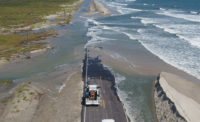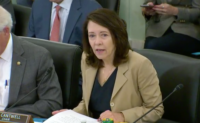For the first time ever, federal roads, bridges and related infrastructure could be built or rebuilt to better withstand the impacts of climate change under a highway bill unanimously approved July 30 by the Senate Environment and Public Works Committee.
The $287 billion highway bill would provide $4.9 billion over five years for resilience projects that will lessen the risk of recurring damage or the cost of future repair resulting from sea-level rise, flooding and other natural disasters. The bill’s climate change title also includes another $5 billion for states to lower highway-related carbon emissions, build out alternative vehicle charging stations, reduce traffic congestion and reduce truck idling at ports.
“We have to deal with the resilience and adaptation, it’s our responsibility,” Sen. Ben Cardin, (D-Del.) said before the 21-0 vote.
The overall bill, including the resilience measures, was endorsed by engineering and environmental groups.
“Partnering with our firms, transportation agencies are tasked with responding to and recovering from hazards such as floods, hurricanes, landslides, and wildfires that threaten human lives and disrupt critical services across communities and states. [This] surface transportation reauthorization bill provides the resources necessary to improve resiliency and durability so that structures can better resist damage, infrastructure can be assessed more accurately following a disaster, and systems can return to service more quickly,” the American Council of Engineering Companies said in a statement.
The Natural Resources Defense Council praised the pro-climate policies in the bill, but criticized other provisions in the highway bill, such as ending review of gas-gathering pipelines on federal lands, as “giveaways” to industry.
The title defines resilience as “the ability to anticipate, prepare for, or adapt to conditions or withstand, respond to and recover rapidly from disruptions.”
Resilience measures that could be funded through the bill include: relocating roadways to a higher elevation, stabilizing slopes, replacing culverts with bridges or upsizing culverts, tide gates, and even improving natural features, such as marshes adjacent to highways, to increase water storage. The highway bill would also fund resilience measures for highway infrastructure that could be affected by drought, wildfires, rockslides, levee and dam failure, and earthquakes. Priority will be given to highways that are evacuation routes.
Under the title, $3.9 billion of the money will be distributed to states based on formula, while $1 billion of the money will be set aside for competitive grants.
The resilience measure was welcomed by the Portland Cement Association, which has been suggesting a life-cycle cost analysis as a way to ensure that resilience is a palatable concept for everyone involved.
“A life cycle analysis … allows the people making the decisions to, to take an engineering and economic analysis of the long-term costs or the overall cost of our project,” Mike Ireland, president and CEO of PCA said in a conversation with ENR early this month. “Oftentimes the cheapest solution may not be the best long-term solution. If you've got an asset like a highway, you want that to last 60, 70 a hundred years.”
Under the bill, a life-cycle analysis isn’t required for resilience projects. Following the Senate committee vote the PCA said it will be closely tracking the resiliency provisions in the bill.






Post a comment to this article
Report Abusive Comment